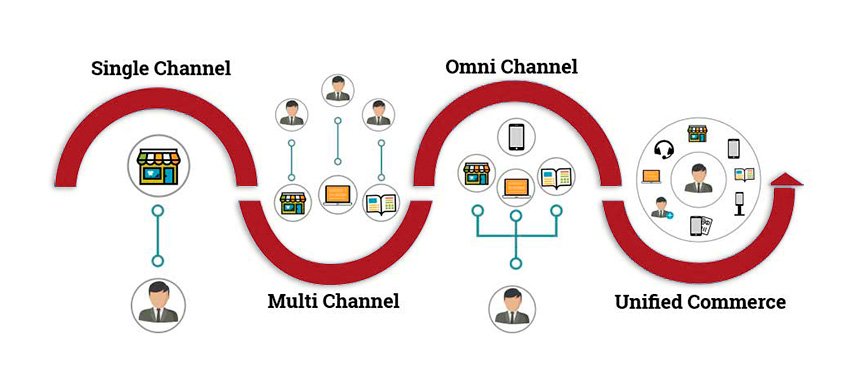Do you still think Omnichannel is the client in the center of your business? Think Again! You probably still doesn’t know about the Unified Commerce!
Unified Commerce is the new practical concept to increase sales. It’s idea is to relate all information from the many different platforms of a single company, both from the physical, end digital store.
Unified Commerce idea is to offer the user (consumer) a complete experience, giving the option to interact in many channels to realize the buying act, but unlike Omnichannel, the Unified Commerce posses a single platform to manage all these channels, not only for selling. Important information, like the sales history, payments and supports requested of a single client communicates with themself not only in the online channels (e-Commerce, market places, social media, etc…) but in the physical store too.

Unified Commerce gives the consumer and the company all the information that a single consumer made in the store, no matter if is in the physical or digital ambience.
What’s the difference between Unified Commerce and the Omnichannel?
Omnichannel is when the store has integration with all it’s sales channel. For example, a client can find a product in your social media, go into your physical store to check the information of the product and finalize the buying process through the virtual store. But not necessary all these information are intertwined. If the client bought 2 products in the companys physical store (using his social security number during the payment, for example), and buy a third product in the store e-Commerce later, he won’t have the bought history of the previously 2 items acquired previously in the physical store.
In a few words, Omnichannel is the integration of many sales platforms interwined to make the sell, but not necessary exchanging all informations, like buy\sell history, payments and support tickets of a single user (client).
Unified Commerce works in a more intelligent way, because it not only sell in multiple channels (like the omnichannel does too), but unifies all the buying information in a single platform
 If a client bought more then one product in the physical store and one more in the e-Commerce, he will have a buy history of all the bought products he had made in a single registered user account. This is good for the company and the client for the following reasons:
If a client bought more then one product in the physical store and one more in the e-Commerce, he will have a buy history of all the bought products he had made in a single registered user account. This is good for the company and the client for the following reasons:
Advantages for the company:
- It makes accurate the recommendation of other products that may please the user, even being the first time he is buying in the virtual store, based in his bought history from the physical store previously, increasing the chances of a user buy more the one product in the company e-Commerce.
- Schedule digital market campaigns (like social media messages or e-mail marketing) informing products that are more accurate for a specific client to buy.
- Create reports based on bought history of the company clients to know which products have more demmand, not only in the e-commerce, but in the physical store as well.
Advantages for the client:
- If the client is buying for the first time in the virtual store and use the information (for example it’s social security number) in the digital user account, having a bought history in the physical store assures the client the webstore is true, and not some ruse to still money.
- In the user account and being logedin the virtual store, the client can receive suggestions of other products that he didn’t even know it had in the virtual store, based in his bought history from the physical/digital store.
Another advantage is, with the bought history information from multiple platforms unified, even the physical store attendants, when they are finalizing the buying process of a client, can recommend other products based in the buy information of the virtual store.
The idea behind omnichannel was to put the consumer in the center of the company, but in the end the only thing omnichannel offered was the buying process in multiple platforms. Unified Commerce is, indeed, the consumer in the center of the company, not only because it offers the selling products in multiple platforms, but the company and the consumer have accesses to the information, like buy\sales, payments and support history in a single platform, not mattering where the consumer finalized the buying process previously.

Unified Commerce brings many benefits, specially for the business person and its company.
Unified Commerce brings many advantages, but it must be done correctly to bring positive results
Unified Commerce greatest challenge is in how to interwind these information in a single ambience. The integration process requires a bit more care because if it’s made wrong, the result can be more negative then positive, like the virtual store credibility loss or the consumer withdrawn during the buying process (or even before that!).
This happens because if the integration is not made in the correct way and aligned with its many platforms, a product can have a price shown in the social media and another in the virtual store, or a specific product can be counted in stock in the e-Commerce, but actually it doesn’t have any more available in the physical store (these problems can happen in Omnichannel too).
If a client tries to buy a product thinking the price is a specifc one in the social media, and when it goes buy a product on the e-commerce the price is different (specially when it costs more), it’s not only a big buy withdrawn possibility as it’s a loss of credibility.
Its not different when the client puts the product in the e-Commerce buying cart, since in the digital ambience informs it has the product in stock, but in the physical store the product is not available any more. This makes necessary for the company to contact the client to inform the product is not available, annoying the client and the company.

The client positive experience is one of the most accountable factor of buying and branding loyalty.
Knowing this, when you adapt your company with Unified Commerce, we always recommend a virtual store consultant to make sure that everything will work as intended, bringing positive results and not the opposite.







Responder